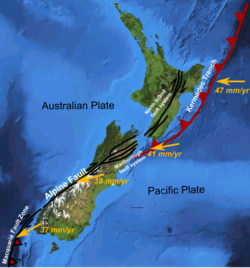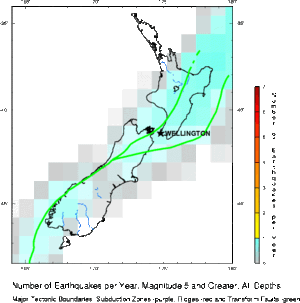Earthquakes in New Zealand: Difference between revisions
| Line 70: | Line 70: | ||
|- |
|- |
||
| 15 July 2009 || [[2009 Fiordland earthquake|Fiordland]] || 7.8 || 0 |
| 15 July 2009 || [[2009 Fiordland earthquake|Fiordland]] || 7.8 || 0 |
||
|- |
|||
| 4 September 2010 || [[2010 Christchurch earthquake|South Island]] || 7.4 || 0 |
|||
|} |
|} |
||
Revision as of 17:09, 3 September 2010

Earthquakes occur regularly in New Zealand as the country forms part of the Pacific Ring of Fire, which is geologically active. About 14,000 earthquakes, most of them minor, are recorded each year.[1] About 200 of these are strong enough to be felt.[2] This affects the culture of the country, in the form of general awareness, historical events, disaster planning and building regulations.
Distribution

Most earthquakes in New Zealand occur along the main ranges running from Fiordland in the southwest to East Cape in the northeast. This axis follows the boundary between the Indo-Australian and Pacific plates. Large earthquakes are less common along the central Alpine Fault, where the plates are not subducting and the forces are accommodated in different ways.
The largest city within this high risk zone is the nation's capital, Wellington, followed by Napier and Hastings. All these cities have experienced severe earthquakes since European settlement.
Societal effects
This section needs expansion. You can help by adding to it. (June 2008) |
As a nation, New Zealand takes discreet pride in its seismic volatility,[citation needed] and the nickname Shaky Isles is sometimes used for the country.[3] Quite early on, European settlers were faced with the reality of earthquakes in their new home. On 26 May 1840, the new settlement of Port Nicholson was struck by the first of a number of earthquakes and tremors.[4]
Public education
The New Zealand Earthquake Commission (EQC) provides public education to much of the country. As outlined in its statement of intent it hopes to provide "public education about seismic hazards and methods of reducing or preventing seismic disaster damage." The EQC sponsors exhibitions on seismic hazards in the Te Papa Museum of New Zealand, and is responsible for social marketing campaigns.[5] An extensive advertising campaign by the EQC across New Zealand's main television networks ran from June 2005 to June 2006. The adverts outlined the risks earthquakes pose to New Zealand and measures households can take to "Quake Safe their house." The slogan used throughout EQC Quake Safe campaigns is "Fix. Fasten. Forget."[6] Additionally in October 2006 many households received free "EQ-IQ" fridge magnets from the EQC.[7]
Building regulations
This section needs expansion. You can help by adding to it. (June 2008) |
Early settlers learned fairly quickly the importance of using appropriate building methods in an earthquake-prone country. The 1848 earthquake, centred in Marlborough, caused great damage to the brick and masonry buildings in Wellington, and the city was rebuilt mainly in wood; consequently it suffered comparatively little damage in the 8.2 magnitude earthquake of 1855, which lifted the land 2–3m.[8]
Major earthquakes
| Date | Location | magnitude | Fatalities | Images |
|---|---|---|---|---|
| 8 July 1843 | Wanganui | 7 | 2 | |
| 16 October 1848 | Marlborough | 7.5 | 3 | |
| 23 January 1855 | Wairarapa | 8.2 | est. 5–9 | |
| 23 February 1863 | Hawke's Bay | 7.5 | ? | |
| 19 October 1868 | Cape Farewell | 7.5 | ? | |
| 1 September 1888 | North Canterbury | 7.1 | 0 | Images from the collection of the Museum of New Zealand Te Papa Tongarewa |
| 12 February 1893 | Nelson | 6.9 | ? | |
| 9 March 1929 | Arthur's Pass | 7.1 | ? | |
| 17 June 1929 | Murchison | 7.8 | 17 | |
| 3 February 1931 | Hawke's Bay | 7.8 | 256 | Images from the collection of the Museum of New Zealand Te Papa Tongarewa |
| 13 February 1931 | Hawke's Bay | 7.3 | - | |
| 5 March 1934 | Pahiatua | 7.6 | 2 | |
| 24 June 1942 | Wairarapa | 7.2 | 0 | |
| 2 August 1942 | Wairarapa | 7.0 | 1 | |
| 24 May 1968 | Inangahua | 7.0 | 3 | |
| 2 March 1987 | Edgecumbe | 6.3 | 0 | |
| 6 February 1995 | East Cape | 7.0 | 0 | |
| 22 August 2003 | Fiordland | 7.1 | 0 | |
| 22 November 2004 | Puysegur Trench | 7.2 | 0 | |
| 20 December 2007 | Gisborne | 6.8 | 1 | |
| 15 July 2009 | Fiordland | 7.8 | 0 | |
| 4 September 2010 | South Island | 7.4 | 0 |
See also
References
Bibliography
- Dench, Alison (2005); Essential Dates: A Timeline of New Zealand History (Auckland, Random House) ISBN 1869416899
- Eiby, G. A. (1957); Earthquakes (London, Frederick Muller) Page 159 has Table of (16) Major Earthquakes in New Zealand 1848-1942, from R. C. Hayes.
- Henderson, J (1937); The West Nelson Earthquakes of 1929, Bulletin No. 55 of Department of Scientific and Industrial Research (Wellington, Government Printer)
Notes
- ^ Radio NZ news report on 2007 Gisborne earthquake
- ^ Earthquakes: The Short Story, Te Ara Encyclopedia of New Zealand
- ^ "New Zealand's land and environment"Ministry for the Environment
- ^ Dench, p 57
- ^ EQC Statement of Intent [1] EQC Statement of Intent
- ^ "EQC Annual Report 2006-2007"EQC Annual Report 2006-2007
- ^ "EQC Annual Report 2005-2006"EQC Annual Report 2005-2006
- ^ McSaveney, Eileen 'Earthquakes', Te Ara - the Encyclopedia of New Zealand, updated 21-Sep-2007
